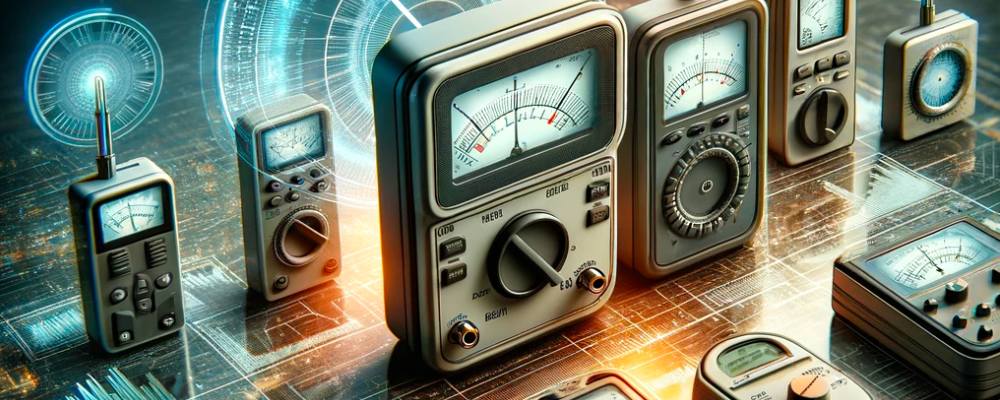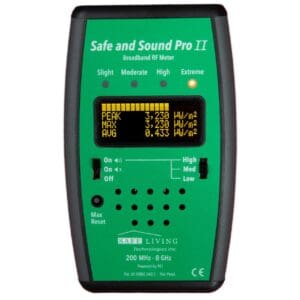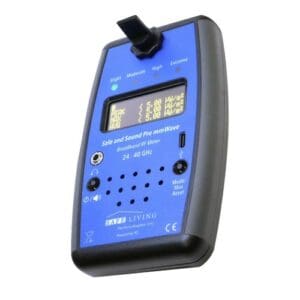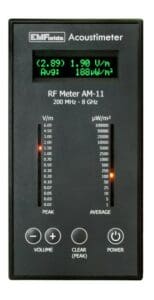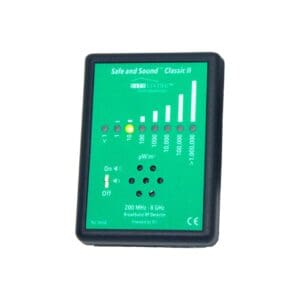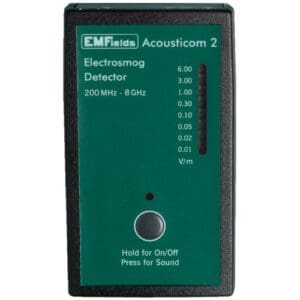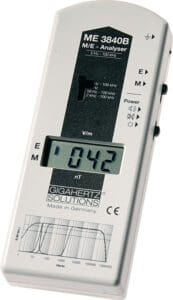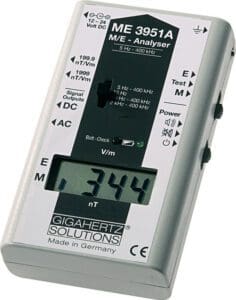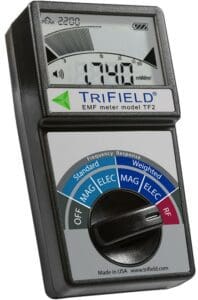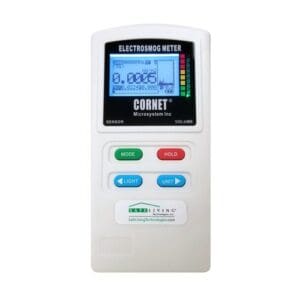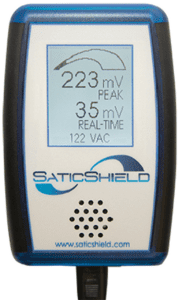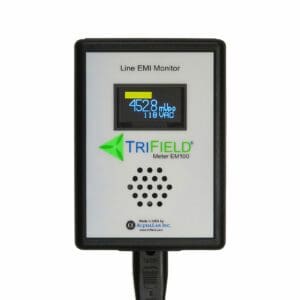Purchasing an EMF (Electromagnetic FieldIn the context of electromagnetic fields (EMF), the term "field" refers to a region in space where electric and magnetic forces are exerted. An electromagnetic field is generated by electrically...) meter is increasingly important in our technology-driven world. EMF meters are crucial for detecting and measuring the levels of electromagnetic radiationElectromagnetic radiation refers to the waves of the electromagnetic field, propagating through space, carrying electromagnetic radiant energy. It includes a wide range of electromagnetic waves, from very long radio waves... emitted by everyday devices like smartphones, laptops, and Wi-Fi routers. Given the growing concerns about the potential health risks associated with prolonged EMF exposure—such as headaches, fatigue, and even more serious long-term effects—it’s vital for individuals, especially those sensitive to EMF, to monitor their environment. These meters empower users to make informed decisions about their exposure and take necessary steps to reduce it, enhancing overall health and wellbeing.
4 Different Types of EMF Meters
When you want to choose your first EMF meter, often times your first stop is Google (that’s probably how you got here!). And then you’ll find a post that discusses — and maybe ranks — different models of EMF meters.
Here’s the problem with that: these articles often treat EMF meters as one type of product. But they’re not!
There are actually four (4!) different types of EMF meters. And understanding the differences between the different types of EMF meters is crucial for accurately measuring and assessing various forms of electromagnetic radiation"Radiation" in the context of Electromagnetic Fields (EMF) refers to the process by which energy is emitted and transmitted through space or a material medium in the form of electromagnetic... in your environment.
The four primary types of EMF meters are:
- Power Density"Power density" is a key concept in the fields of physics and engineering, referring to the amount of power (time rate of energy transfer) per unit volume. In more practical... Meters: These are used to measure radio frequencyRadio Frequency (or RF), a subset of EMF, encompasses electromagnetic wave frequencies ranging from about 3 kilohertz (kHz) to 300 gigahertz (GHz). These frequencies are extensively used in modern wireless... (RF) or microwave (MW) radiation — the type of EMF used in wireless communications like cell phones, WiFi and bluetoothFrom the perspective of someone concerned about the health effects of electromagnetic radiation, understanding Bluetooth radiation is crucial, especially in our increasingly wireless world. Bluetooth technology, ubiquitous in our daily....
- Electric Field Meters: These meters are used to measure the electric field component of low frequency"Frequency" in the context of electricity, Electromagnetic Fields (EMF), and wireless communication, can be thought of as the number of times something happens in a second. Specifically, it refers to... radiation from power"Power" in a scientific context refers to the rate at which work is done or energy is transferred. In simpler terms, it's how fast something is using energy. For example,... lines and AC appliances like refrigerators and heaters.
- GaussThe "gauss" is a unit of measurement used to quantify the strength of a magnetic field. Named after the German mathematician and physicist Carl Friedrich Gauss, it helps in understanding... Meters: These meters are used to measure the magnetic field component of low frequency radiation from power lines and AC appliances like refrigerators and heaters.
- Dirty ElectricityDirty Electricity, also known as electrical pollution, refers to the presence of irregularities or distortions in the normal electrical current within a wiring system. These distortions, which deviate from the... Meters: DE meters are used to measure the amount of dirty electricity on the electrical wiring in your home or office.
Each type of EMF meter plays a pivotal role in understanding and managing electromagnetic exposure. While power density meters focus on RF radiation, electric field meters on electric fieldsDefinition and Nature of Electric Fields Electric fields are a fundamental aspect of electromagnetic fields, created by electric charges, either stationary or moving. These fields represent the force that electric..., gauss meters on magnetic fieldsDefinition and Nature of Magnetic Fields Magnetic fields are a fundamental aspect of electromagnetic fields, produced by moving electric charges (electric currents). The strength of a magnetic field is measured..., and dirty electricity meters on electrical line pollution, together, they provide a comprehensive approach to assessing and mitigating EMF risks in various environments.

Want to Slash Your EMF Health Risks?
Want to Slash Your EMF Health Risks?
Good! Learn the one small change you should make right now.
Most people are interested in the radiation levels from wireless devices like cell phones and WiFi. So most people are therefore interested in power density meters. But wireless radiationDefinition and Characteristics Wireless radiation refers to the electromagnetic radiation emitted by wireless devices and technologies. It encompasses a range of frequencies within the electromagnetic spectrum, typically from 300 MHz... may not be your most significant source of exposure. And it’s obviously vital to select the right type (or types) of EMF meters for what you want to measure.
So in this review, I will address each type of meter separately.
Key Considerations
Before we get into this, let’s talk about what you should be looking for in a new EMF meter, in terms of features.
When evaluating EMF meters, accuracy is paramount. Now, keep in mind, this article discusses consumer-grade meters. Because these are the types of meters that are affordable and practical for consumers. Obviously, expert-grade meters are going to be more accurate — but they cost thousands of dollars, so I don’t address them here.
A high-quality EMF meter should provide reasonably precise readings of various types of EMF radiation. Additionally, consider the frequency range of the device; a broader range means more types of EMF can be detected, offering a complete assessment of potential risks.
User-friendliness is another critical factor. A good EMF meter should be easy to use, with a clear display and intuitive controls. For those who are not technically inclined, a device that offers straightforward, easy-to-interpret results is preferable. Some advanced meters also come with features like data logging and connectivity options, which can be useful for those who wish to track EMF exposure over time or require detailed analysis for professional purposes.
Power Density Meters
Power density meters are designed to measure the intensity of radiofrequency (RF) radiation. This type of EMF is commonly emitted by wireless communication devices like cell phones, Wi-Fi routers, and broadcast towers. Power density meters assess the power density of RF radiation in an area, which is crucial for understanding exposure levels in environments saturated with wireless technology. Because these meters measure power over a given area, they provide readings in units such as milliwatts per square meter (mW/m²) or microwatts per square meter (µW/m²).
Safe & Sound Pro II
$399
We’ll start our review with what I personally consider to be the best, highest-quality, most accurate, consumer-grade RF meter — the Safe & Sound Pro II from Safe Living Technologies.
The Safe and Sound Pro II EMF Meter has garnered attention for its advanced capabilities in measuring radiofrequency (RF) fields, proving to be a reliable tool for both professional and personal use. Its design is focused on accurately detecting a wide range of RF sources, both internal and external, making it an ideal instrument for assessing RF radiation in various settings. The meter effectively detects emissions from common devices like cell phones, Wi-Fi routers, and Bluetooth-enabled tech, as well as external sources such as cell towers and neighbor’s Wi-Fi.
One of the meter’s standout features is its crisp, easy-to-read OLED screen, which displays detailed measurements of RF levels including instantaneous peak, peak hold, and average readings. This numerical display, supplemented by a set of LEDs indicating RF exposure levels from “slight” to “extreme,” simplifies the process of gauging exposure. Such clear and straightforward visualization of data makes the Safe and Sound Pro II user-friendly and accessible for a wide range of users.
The technical specifications of the Safe and Sound Pro II are impressive. It covers a broad frequency range from 200 MHz to 8 GHz, ensuring comprehensive RF field measurement. Its sensitivity to both digital and analog RF/microwave fields, including the lower and mid-band 5G"5G" refers to the fifth generation of wireless communication technology, a step up from the previous 4G, 3G, and 2G networks. It's designed to provide faster internet speeds, more reliable... frequencies, makes it a highly versatile tool. The meter’s unique audio feature is particularly helpful for identifying different RF sources based on their sound patterns. Additionally, its peak hold function, long battery life (12-15 hours), and high measurement sensitivity (measuring power densities up to 2,500,000 µW/m²) further enhance its utility for thorough and accurate RF field assessment.
In summary, the Safe and Sound Pro II stands out for its comprehensive RF detection capabilities, user-friendly interface, and innovative features like the audio function and detailed OLED display. Its ability to accurately measure a wide range of RF sources, along with its practical design, makes it a top choice for those seeking a reliable and efficient RF meter.
Top 5 Features:
- Broad Frequency Range: It detects frequencies from 200 MHz up to 8 GHz, encompassing a wide range of RF sources, including 5G signals within this spectrum.
- Detailed Digital Display: The meter provides a clear OLED screen displaying numerical readings of peak, max peak, and average RF levels. This ensures accurate and easy-to-read measurements for users.
- Sound Signature Analysis: An innovative audio function transforms RF signals into distinct sound patterns, aiding in the identification of various RF sources. This feature is especially useful for distinguishing different types of RF emissions, such as cell towers, smart meters, and Wi-Fi routers.
- High Sensitivity and Accuracy: The meter is designed for high sensitivity and accuracy, capable of detecting both digital (including 5G) and analog RF/microwave fields. It measures power densities up to 2,500,000 µW/m² and as low as 0.001 µW/m², catering to a broad range of measurement needs.
- Practical Design Features: It includes a set of helpful bar graph and LEDs for quick assessment of field strengths, a peak hold function for capturing maximum exposure levels, and a long battery life of 12-15 hours, ensuring ease of use and practicality in various settings.
Learn more about the Safe & Sound Pro II meter >
Safe & Sound Pro mmWave Meter
$849
Safe Living Technologies makes another entry on this list, with their Safe & Sound Pro mmWave Meter. It’s very similar to the Safe & Sound Pro II — except it is specifically designed to measure 5G frequencies, in the 20-40 GHz range. Priced at $1,149.00, it stands as North America’s first consumer-level high-band 5G meter, offering a unique combination of professional accuracy and relative affordability. And it is the only true 5G to make this list.
The meter’s primary selling point is its ability to detect and measure 5G in the high mmWave band, ranging from 20 GHz to 40 GHz. This broad spectrum coverage is significant as it includes most of the frequencies used for current 5G networks, which are typically below 8 GHz. The meter’s digital display, which shows readings in micro watts per square meter (µW/m²) and volts per meter"Volts per meter" (V/m) is a unit of measurement in the International System of Units (SI) that quantifies the strength of an electric field. This unit is particularly relevant in... (V/m), is enhanced by its audio function, peak and average readings, and a maximum peak hold feature. These functionalities make it easier for users to quickly assess the RF levels in their environment, particularly those emitted by common sources like 5G cell towers, 5G cell phone emissions, and higher frequency radar devices.
The meter has a frequency response of +/- 5dB from 20-40 GHz, effective down to 18 GHz with reduced tolerance. Its minimum measurable signal is 5 µW/m², and it can measure up to 500,000 µW/m², or even up to 50,000,000 µW/m² with an attenuator. Additionally, the meter offers an optional “Horn” antenna for directional measurement, enhancing its versatility. This antenna has a frequency response of +/- 6dB from 25-40 GHz and can measure signals as low as 0.5 µW/m² and as high as 30,000 µW/m², or up to 3,000,000 µW/m² with an attenuator. The 20 dB fixed attenuator feature allows the meter to display higher power density signals by a factor of 100, broadening its range of detectable signals.
Top five features:
- High-Band 5G Detection: It specifically detects and measures 5G in the high mmWave band, covering frequencies from 20 GHz to 40 GHz, making it one of the first meters of its kind for consumer-level high-band 5G detection in North America.
- Professional Accuracy: Designed for professional accuracy, the meter offers detailed measurements on a digital display in both micro watts per square meter (µW/m²) and volts per meter (V/m), providing reliable and precise readings.
- Wide Frequency Response: The meter has a frequency response of +/- 5dB from 20-40 GHz, effective down to 18 GHz with reduced tolerance, ensuring comprehensive coverage of high-frequency RF sources.
- Versatile Measurement Capabilities: It includes both an optional “Horn” antenna for directional measurements and a 20 dB fixed attenuator to extend the range of measurable power densities, thereby enhancing its adaptability in various measurement scenarios.
- Audio Functionality: An audio function is included to assist in the identification and differentiation of RF sources, turning modulated RF signals into distinct sound patterns, which is a valuable tool for pinpointing specific types of RF emissions.
Learn more about the Safe & Sound mmWave meter >
EMFFields Acoustimeter AM-11
$419
The EMFields Acoustimeter AM-11 is a sophisticated RF detector, highly regarded for its user-friendly design and advanced capabilities in measuring radiofrequency and microwave radiationMicrowave radiation is a form of electromagnetic radiation with wavelengths ranging from one meter to one millimeter; with frequencies between 300 MHz (0.3 GHz) and 300 GHz. This type of... It’s a more expensive version of the Acousticom 2 RF Detector, the Acoustimeter AM-11 includes a key new feature: a digital display. This allows the meter to provide you with specific readings, rather than just giving you a range of possible levels.
Top 5 Features:
- Wide RF Measurement Range: The Acoustimeter AM-11 covers an extended frequency range from 200 MHz to 8.0 GHz, encompassing the frequencies used by most modern communication systems. This broad spectrum ensures that it can accurately measure RF emissions from a wide array of sources including mobile phones, Wi-Fi, and smart meters.
- Audio Signal Analysis and OLED Display: The meter is equipped with an audio output for source identification, transforming RF signals into audible sound patterns. This unique feature, combined with a clear two-line OLED display, facilitates easy identification and differentiation of various RF sources. The display shows peak, peak hold, and average levels of RF electromagnetic fields, providing precise measurements with a slower update speed for ease of reading.
- User-Friendly and Reliable: The AM-11 is designed for user convenience and reliability. It comes with two series of graduated LED lights for a quick visual indication of RF intensity. The instrument is highly suitable for those with severe electrosensitivity, as it is sensitive down to 0.02 V/m. Its portability, combined with a battery life of approximately 15 hours on standard alkaline batteries, makes it suitable for both professional and personal use.
- Sound Demodulation Feature: The meter’s sound demodulation can be heard at RF levels below 0.02 V/m, adding another layer to its detection capabilities. The speaker assists users in recognizing the type of device creating the RF levels, though it’s noted that sound samples are a rough guide only and may be less easily identified in areas with multiple RF sources.
- Professional Accuracy and Sensitivity: The AM-11 is known for its professional accuracy and sensitivity, with a very fast response time and true mathematical time-averaged rolling average of thousands of samples. This level of accuracy is particularly important for adhering to international standards based on true average power. The meter’s internal antenna is optimized for signal measurement, although it under-reads if the source is directly in front of the meter due to the OLED display acting as an RF screen.
Power Density Meters on a Budget
If you’re looking for a meter that costs a bit less than those listed above, there are some options that you can consider.
These are still high quality meters. The major trade-off is that you don’t get digital readouts of the EMF levels. Instead, the readings tell you what general range (usually to an order of magnitude) those readings fall into. So the meter is still accurate, but the display doesn’t provide the same level of accuracy as found in the higher cost meters.
Safe & Sound Classic III
$169
The Safe and Sound Classic III RF Detector is a compact and user-friendly device designed for detecting radio frequency/microwave radiation. Its simple design and ease of use make it accessible to individuals without technical experience, and it’s engineered by Safe Living Technologies, a company known for its expertise in RF engineering.
Overall, the Safe and Sound Classic III RF Detector is well-suited for those looking for a simple yet effective way to measure RF radiation, especially for users who are electrically hypersensitive or for those seeking to adhere to Building Biology guidelines in sleeping areas. Its combination of broad detection capabilities, ease of use, and enhanced audio-visual feedback makes it a reliable choice in its price range.
Top 5 Features:
- Enhanced Visibility and Audio Feedback: The detector now features more lights for better visibility of RF levels, a bigger and louder speaker, and more sounds for improved results in identifying RF sources. These enhancements make the detector more effective in both visual and audio identification of RF exposure.
- Broad Detection Range: It has a true response detection range from 200MHz to 8GHz, which covers a wide spectrum of common RF sources. This range ensures that it can detect emissions from various devices such as smart meters, wireless routers, cell towers, and more.
- User-Friendly Design: The meter is designed to be easy to use and understand, with no technical experience required. It has a small, durable, and compact handheld design, measuring just 65mm X 90mm X 21mm (2.5″ X 3.5″ X 0.8″), and is powered by 3 AAA batteries with a battery life of 27 to 40 hours. This makes it highly portable and convenient for on-the-go measurements.
- Sound Signature Analysis: The detector includes a sound signature analysis feature that assists with the identification of RF sources. This feature is beneficial for a more nuanced understanding of the type and intensity of RF emissions in your environment.
- Comprehensive RF Source Detection: It can detect a range of RF sources, including emissions from smart meters, wireless routers, cell phones, cordless home phones, Bluetooth devices, baby monitors, airport radar, microwave oven leakage, and video game consoles. This comprehensive detection capability makes it a versatile tool for assessing RF exposure in various settings.
Learn more about the Safe & Sound Classic meter >
EMFFields Acousticom 2 RF Detector
$199
The EMFields Acoustimeter 2 RF Detector has received positive feedback for its functionality and design. This small but powerful radio frequency/microwave meter is celebrated for its ease of use and portability. Weighing just 140g (including the battery) and measuring 110 x 63 x 21 mm, it fits comfortably in the hand and is convenient for on-the-go measurements. It includes a carry pouch, further enhancing its portability. Its battery life of up to 10 hours on a standard alkaline battery adds to its practicality for extended use.
The Acousticom 2’s has a wide frequency range of 200 – 8,000 MHz with a typical accuracy of ±6 dB. The sensitivity for peak display ranges from 0.01 to 6.00 volts per meter (V/m), equivalent to 0.5 to 100,000 peak µW/m2. This wide range allows it to detect a variety of RF sources, including cordless phones, WiFi routers/modems, smart meters, mobile phones, and digital baby monitors. A standout feature is the LED light system, which changes from green to red based on RF intensity, offering a quick visual indicator of the level of electromagnetic pollution. This feature is particularly beneficial for beginners who might not fully grasp the implications of specific readings.
The Acousticom 2 is designed for simplicity. It uses V/m as its unit of measurement, which is considered equally reliable for detecting RF signals compared to meters that use milliwatts. The meter provides peak readings, the highest sampled reading, which is crucial as wireless technologies often emit frequent bursts of RFs. The meter can detect a wide range of frequencies, from 200 MHz up to 8 GHz, covering a broad spectrum including TETRA, all mobile phone systems (including 4G/LTE), Smart Meters, and all WiFi and WiMax frequencies. Its ease of use and broad detection capabilities make it an ideal choice for those on a budget or with strong electromagnetic sensitivity, though it might not provide the detailed readings offered by more advanced meters.
Top 5 Features:
- Wide Frequency Range: It measures RF and microwave radiation across a broad frequency range from 200 MHz to 8,000 MHz, ensuring comprehensive coverage of various modern wireless technologies.
- Portability and Ease of Use: The Acousticom 2 is extremely portable, weighing only 140g with a compact size of 110 x 63 x 21 mm. Its simple controls and easy-to-read results make it user-friendly, even for those new to RF detection.
- Visual LED Indicator System: The device features a column of LED lights that change from green to red depending on the RF intensity, providing a quick and intuitive visual representation of electromagnetic pollution levels.
- Peak Measurement Sensitivity: With a sensitivity range for peak display from 0.01 to 6.00 volts per meter (V/m), the Acousticom 2 is capable of detecting even low levels of RF radiation, making it suitable for a variety of environments and applications.
- Audio Signal and Alarm Feature: It includes an audio signal for identifying the source of radiation, which can be switched on and off, and an alarm feature for high levels of RF. This audio component is particularly useful for further analyzing the type and intensity of RF sources.
“Budget Friendly” Meters to Avoid
Now, while I just covered a couple of actual useful budget-friendly options for those with limited funds to invest, there are still plenty of EMF meters available that are even cheaper.
Do not waste your money on these!
Examples include:
- Meterk EMF Meter
- KMoon EMF Meter
- Erickhill EMF Meter
If you spend less than ~$150 on a power density meterConcept and Definition A Power Density Meter is a specialized instrument used to measure the power density of electromagnetic fields (EMFs). Power density, defined as the amount of power per..., you are basically throwing your money away. Wait, save up, and get one of the ones listed above when you can afford it.
Electric and Magnetic Field Meters
Electric field meters specialize in measuring the strength of electric fields. These fields are produced by voltage in electrical systems and are present around any electrical device or wiring, even when there is no current flowing. Electric field meters measure this field strength in volts per meter (V/m), making them essential for identifying sources of electric field emissions, such as faulty wiring or electrical appliances. They help ensure that living and working environments adhere to recommended safety levels for electric field exposure.
Gauss meters, also known as magnetic field meters, are used to detect magnetic fields generated by the flow of electric current. These meters are particularly useful near electrical appliances, power lines, and other sources of electric current. Magnetic fields are measured in units like milligauss (mG) or microtesla (µT). Gauss meters are instrumental in assessing magnetic field exposure in various environments, which is important for understanding potential health risks and for investigating electromagnetic interference in sensitive electronic equipment.
While it is possible to purchase separate electric field meters and gauss meters, the ones I review here are 2-in-1 models — they include the ability to measure both electric and magnetic fields. And all the models I am reviewing come from Gigahertz Solutions.
Gigahertz Solutions GmbH, based in Langenzenn, Germany, is a leader in the development and production of high-frequency and low-frequency field strength measurement technology. They are known for their state-of-the-art measurement and testing technology, which is used in laboratory settings as well as in production environments. Their equipment is capable of reaching up to 30 GHz and is sourced from leading global producers. Gigahertz Solutions GmbH is recognized for its quality management, which undergoes annual control.
Here I discuss two of their meters that combine electric field meter functionality with a gauss meter.
Gigahertz Solutions ME3840B
$333
The Gigahertz Solutions ME3840B is a mid-level meter highly recommended for measuring electric and magnetic fields. It stands out for its frequency range selector, a feature that allows users to select specific settings for accurate measurements, avoiding false readings from other sources. This selector is particularly beneficial for distinguishing between different types of electromagnetic sources, enhancing the meter’s precision and versatility.
Key features and capabilities of the ME3840B include:
- Frequency Range: The ME3840B operates over a broad frequency range from 5 Hz to 100 kHz. This wide range makes it capable of detecting a variety of electromagnetic sources, from standard household appliances and electrical wiring to higher frequency sources like energy-efficient appliances and fluorescent lighting.
- Separate Settings for Electric and Magnetic Fields: The meter has distinct settings for measuring electric and magnetic fields, which enhances its accuracy and utility. It can measure magnetic flux density"Magnetic Flux Density" is a fundamental concept in physics and electromagnetism, playing a crucial role in our understanding of waves, Electromagnetic Fields (EMF), frequency, and energy. The term is deeply... in a range from 1 to 1999 nT and electric field strength from 1 to 1999 V/m, making it suitable for a wide array of applications.
- Accuracy and Sensor Technology: The ME3840B boasts an accuracy of +/- 2 %, +/- 14 digits at 50/60 Hz. It is equipped with an E-field sensor for electrical low-frequency fields and an H-field sensor for one-dimensional magnetic low-frequency fields, ensuring precise measurements across its operating range.
- Audio Analysis Feature: The meter includes an audio analysis feature that produces an acoustic signal proportional to the field strength, similar to a Geiger counter effect. This audio feedback is useful for identifying the intensity and nature of the electromagnetic fields being measured.
- User-Friendly Design: Designed for ease of use, the ME3840B is a practical choice for both professionals and average individuals interested in monitoring electromagnetic fields. Its user-friendly design, combined with accurate detection capabilities, makes it a reliable tool for assessing and managing EMF exposure in various environments.
The Gigahertz Solutions ME3840B is a versatile and accurate EMF meter, ideal for those who need a reliable tool for measuring a wide range of electromagnetic sources. Its combination of broad frequency coverage, separate settings for different types of fields, and advanced sensor technology make it a valuable asset for both personal and professional use.
Learn more about Gigahertz meters >
Gigahertz Solutions ME3951A
$589
The Gigahertz Solutions ME3951A meter is a professional-grade EMF (Electromagnetic Field) meter that offers comprehensive features for measuring AC electric and magnetic fields. Here’s a summary of its capabilities and features:
- Wide Frequency Range: The ME3951A covers a broad frequency range from 5 Hz to 400,000 Hz. This range is particularly significant because it allows the device to measure EMF emissions from a variety of modern electronic devices and infrastructure, making it suitable for both personal and professional use in assessing EMF exposure.
- High Sensitivity and Accuracy: The meter is known for its high-end precision, with a measurement capability down to .001 mG for magnetic fields and .1 vM for electric fields. Its accuracy is further enhanced by a built-in frequency filter (F1B2H31) that isolates frequency clutter, allowing for more precise source identification.
- Versatile Measurement Options: It features single-axis measurement combined with easy peak value readings, enabling users to effectively identify the direction of the source of EMF emissions. The meter also offers AC/DC data outputs, which can be connected to specialized equipment for data logging, full audio assessments, and full spectrum analysis.
- User-Friendly Design: The ME3951A is designed for easy use, with an LCD display that provides clear 3.5-digit readings. It also includes an audible tone feature for audio assessment, proportional to the field strength, often referred to as the ‘Geiger Counter Effect’.
- Durable and Reliable: The device comes with a NiMH rechargeable battery and a charging unit, ensuring long-lasting use. It also includes a plastic carrying case for added durability and portability. Gigahertz Solutions backs this meter with a 2-year manufacturer’s warranty, adding to its reliability.
The Gigahertz Solutions ME3951A meter stands out for its comprehensive measurement capabilities, accuracy, and user-friendly features. It is suitable for those who require professional-level EMF measurement, including EMF technicians facing challenges posed by new technologies and manufacturing trends towards energy"Energy" is a fundamental concept in physics, often described as the ability to do work or cause change. In everyday terms, it's what is needed to move things, heat them... efficiency and high performance.
Learn more about Gigahertz meters >
Three Field Meters
Now, while I’ve explained the differences between power density meters, electric field meters and gauss meters, that doesn’t actually mean you need two or three different meters to measure all of these fields. Because there are some meters that combine all three into a single device!
And in fact, these are the two meters I most frequently recommend. Because, while Safe Living Technologies makes the best consumer-grade power density meter, and while Gigahertz Solutions makes the best electric and magnetic field meters, many consumers don’t want to invest in multiple high grade meters.
That’s where these options come in. For a reasonable price, you get all three types of meters, with reasonable accuracy. Professionals won’t use these, but they are great for a wide range of consumers.
TriField TF2
$195
The Trifield TF2 Meter stands out in the world of EMF detectors for its comprehensive capabilities and user-friendly design. As a versatile tool, it measures a wide range of EMF types including radiofrequency (RF), magnetic, and electric fields, making it an excellent choice for both professional and personal use. Its accuracy is particularly noteworthy; the TF2 provides reliable readings that are crucial for assessing EMF exposure in various environments, from homes to workplaces. This accuracy, combined with its ability to detect different types of EMF, ensures users get a complete picture of their electromagnetic environment.
What sets the Trifield TF2 apart is its ease of use. It boasts an intuitive interface that is accessible even to those who are new to EMF detection. The large, clear display and straightforward settings allow for quick readings without the need for extensive technical knowledge. This user-friendliness does not come at the expense of functionality; the TF2 still offers advanced features like peak hold and weighted mode, which are invaluable for more detailed analysis. Its ergonomic design and portability also make it a practical tool for on-the-go measurements.
In terms of value, the Trifield TF2 is a solid investment. While it may be priced higher than some basic EMF meters, its range of features and reliable performance justify the cost. Its robust construction and the reputation of the Trifield brand further add to its appeal, ensuring users that they are getting a quality product. For anyone serious about EMF detection, whether for health reasons, professional assessments, or simply for peace of mind, the Trifield TF2 is an excellent choice that balances functionality, accuracy, and user experience.
Top 5 Features:
- Versatility in EMF Measurement: One of the most significant features of the TF2 is its ability to measure all types of EMF radiation, including magnetic, electric, and radio frequency/microwave radiation. This versatility ensures users can comprehensively assess their exposure to different types of EMF in their environment.
- Three-Axis Magnetic Measurement: The TF2 employs a three-axis sensor for magnetic measurements, enabling it to provide quick and accurate readings regardless of the meter’s orientation. This feature simplifies the process of obtaining precise measurements in various situations and environments.
- Advanced Display and Backlight: The TF2 features a new LCD display, which allows for more accurate readings compared to previous models with needle-based displays. Additionally, it has an adjustable backlight, making the meter usable in low-light conditions. These features contribute to the ease of reading and interpreting the data captured by the device.
- Audio Indicator for Source Detection: An innovative addition to the TF2 is the audio indicator, which emits noise to assist users in locating and understanding EMF radiation sources in their home or office. This auditory feedback is particularly useful in pinpointing specific areas of high EMF concentration.
- Special Frequency Weighting and Peak Hold: The TF2 includes a special frequency weighting mode for measuring electric current from EMF in the human body, which is a crucial aspect for those concerned about the health impacts of EMF. It also features a Peak Hold function, capturing fast pulses to measure rapid digital signals effectively. These specialized functions enhance the meter’s capability to assess EMF exposure accurately and respond to fast-changing or intermittent sources of EMF.
Read my full review of the TriField TF2 here and learn more about it here >
Cornet ED88TPlus
$249
The Cornet ED88T EMF Meter is a highly regarded instrument in the realm of EMF detection, favored for its multifunctional capabilities and user-friendly interface. A standout feature of the ED88T is its ability to measure a broad spectrum of electromagnetic frequencies, including RF (Radio Frequency), LF (Low Frequency), and EF (Electric Field). This makes it an ideal tool for a thorough environmental EMF assessment, catering to both professionals in the field and individuals keen on monitoring their personal spaces. The device’s sensitivity to various types of EMF radiation ensures that users can accurately detect and quantify exposure levels from a range of sources, from cell towers to household appliances.
Ease of use is another significant advantage of the Cornet ED88T. It boasts a compact, handheld design, making it convenient for both in-home evaluations and on-the-go measurements. The meter’s interface is straightforward, featuring a clear LCD screen that displays readings in real time, accompanied by an audio indication which aids in identifying EMF hotspots. This user-friendly design is particularly beneficial for those who are new to EMF meters, allowing for quick adaptation without a steep learning curve. Additionally, the ED88T offers advanced features like data logging and an adjustable backlight, which are useful for conducting more detailed analyses and measurements in various lighting conditions.
In terms of value, the Cornet ED88T strikes a fine balance between functionality and cost. It is priced reasonably, making it accessible to a wider audience without compromising on the quality and range of features offered. The meter’s durable build and reliable performance further solidify its position as a valuable investment for anyone looking to assess and manage EMF exposure. Whether for personal health reasons, professional assessments, or educational purposes, the Cornet ED88T EMF Meter is a versatile, efficient, and trustworthy tool in the world of electromagnetic field detection.
Top 5 Features:
- Tri-Mode Functionality: The most significant feature of the Cornet ED88T is its tri-mode capability, which allows it to measure RF radiation, magnetic fields, and electric fields. This versatility is akin to having three meters in one, providing comprehensive EMF detection.
- Broad Frequency Range and Sensitivity in RF Mode: The meter shines in its RF radiation functionality, boasting a wide frequency range from 100MHz to 8GHz. Coupled with an improved sampling rate of 10,000 samples/sec, it offers excellent sensitivity, making it adept at detecting a variety of RF sources.
- Sound Function for RF Mode: The sound function in RF mode is a distinctive feature that enhances the meter’s usability. This function allows users to hear EMFs, providing an additional layer of information beyond visual readings. It’s especially useful for detecting low levels of EMFs that may not be immediately visible on the display.
- Histogram Function: Another notable feature is the histogram function, displayed on the right side of the LCD screen. It records the last 30 readings since the meter was turned on, which is particularly useful for measuring radiation from smart meters and other devices that emit radiation in short bursts. This feature makes it easier to observe and interpret these intermittent signals.
- Affordability: Despite its extensive range of features and functionalities, the Cornet ED88T is priced competitively. It offers broad functionality, typically found in more expensive EMF meters, at a more accessible price point, making it an excellent value for its capabilities.
Learn more about the Cornet ED88TPlus G2 meter >
Dirty Electricity Meters
Dirty electricity meters, the fourth type, measure electromagnetic interference present on electrical wiring. Dirty electricity refers to the irregular and potentially harmful electrical frequencies that can be generated by certain modern electrical devices and dimmer switches. These meters detect spikes and surges in electrical power lines that are not part of the regular 50/60 Hz electrical frequency. Measuring and mitigating dirty electricity is crucial in environments where there is a high usage of electronic devices, as it can contribute to electromagnetic pollution, potentially impacting health and the performance of sensitive equipment.
Once you’ve taken measurements with these meters, you can then take action to remove or replace the sources of DE or reduce DE levels through plug-in filters or full home filters.
Since these types of meters need to plug into outlets, make sure to get a dirty electricity meter that is designed to work with the power grid where you live.
Satic EMI Line Monitor
$179
The SATIC EMI Line Monitor is a specialized device designed to measure electromagnetic interference, commonly known as ‘dirty electricity’ (DE), in your home or workplace environment. Satic also makes versions for both the North American and the UK power grids.
Some key features include:
- DE Measurement and Visualization: The SATIC EMI Line Monitor effectively measures the levels of dirty electricity present in electrical circuits. It provides both visual and audio feedback, with an LCD display showing a swoosh-shaped line diagram indicating peak interference. The louder the audio feedback, the higher the levels of DE on the line. This real-time feedback is crucial for understanding and managing DE exposure.
- Wide Measurement Range: The device measures interference in millivolts (mV) from peak-to-peak, with a range from 0-2999mV. It records peak mV while also displaying real-time mV, allowing for a comprehensive understanding of DE levels. This wide range is particularly useful for detecting a variety of DE sources within a typical home or office environment.
- Ease of Use and Practicality: The SATIC EMI Line Monitor is designed for simplicity, plugging easily into any electrical outlet. It features an LCD display for easy reading, measures in millivolts, and displays both peak and real-time measurements. The meter is also capable of showing voltage and has an audio indicator for DE levels, making it a practical tool for assessing dirty electricity. Its design also demonstrates the effectiveness of DE filters.
In summary, the SATIC EMI Line Monitor is a valuable tool for anyone looking to measure and manage dirty electricity in their environment. Its ease of use, comprehensive measurement capabilities, and practical feedback mechanisms make it an excellent choice for both personal and professional use in monitoring and mitigating electromagnetic pollution.
Learn more about the Satic Line EMI Monitor here >
TriField Line EMI Meter
$145
The TriField EM100 Power Line Monitor is a specialized device designed to measure electromagnetic interference (EMI) in single-phase AC power lines. Key features include:
- Noise Measurement: It displays total line noise in millivolts peak to peak (mVp-p) with a range of up to 1999.9 mVp-p and a resolution of 0.1 mVp-p. The frequency range for measurement is between 10 KHz and 10 MHz.
- Sound Representation: The EM100 includes a speaker that plays the sound of the EMI, amplitude demodulated. This feature helps in identifying the source of the EMI, whether it’s from a radio station, motor, or electric arc.
- Operating Specifications: The device operates on a voltage range of 85-300 VAC 50/60 Hz and offers a voltage reading accuracy of +/- 1 VAC. It is compact in size (5.2 x 3.6 x 1.6 inches) and lightweight (8 oz), and it comes with a detachable 2-wire power cord rated for 110V in North America.
This monitor is an effective tool for those needing to assess and mitigate EMI in residential or work environments, particularly useful for diagnosing issues with home appliances or electrical wiring.
Conclusion & Next Steps
In this article, I’ve given you a lot to consider. So take your time, weigh the options, and then pick the meter (or meters) that’s right for you.
Once you’ve made your investment, then next step is to learn how to actually use the meter. And towards that end, I’ve made this short video explainer.
And then finally, when you’ve got your measurements, here’s a post that explains what a “safe” level of EMF exposure is.
You can also hop on over to the SYB EMF Health Effects app, enter your measurements, and see what the science has to say about the potential health effects.
